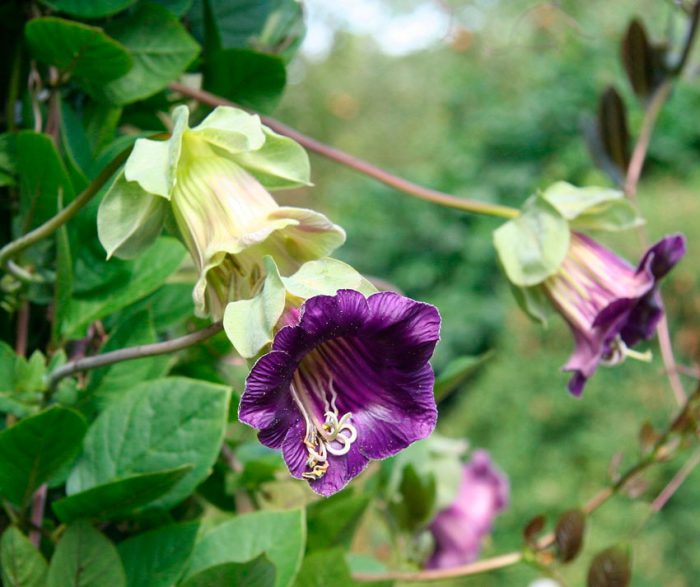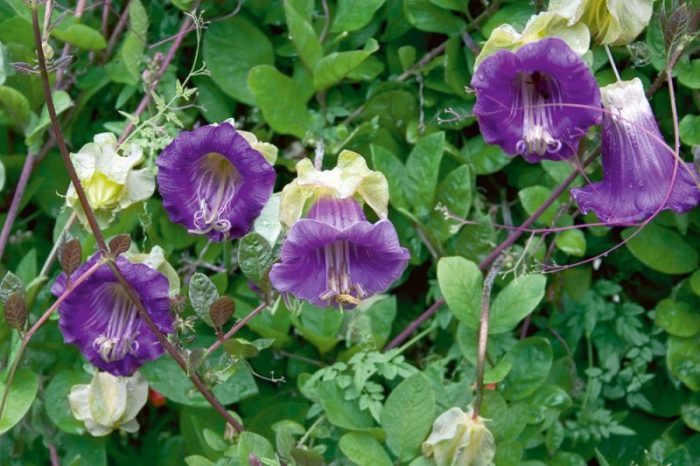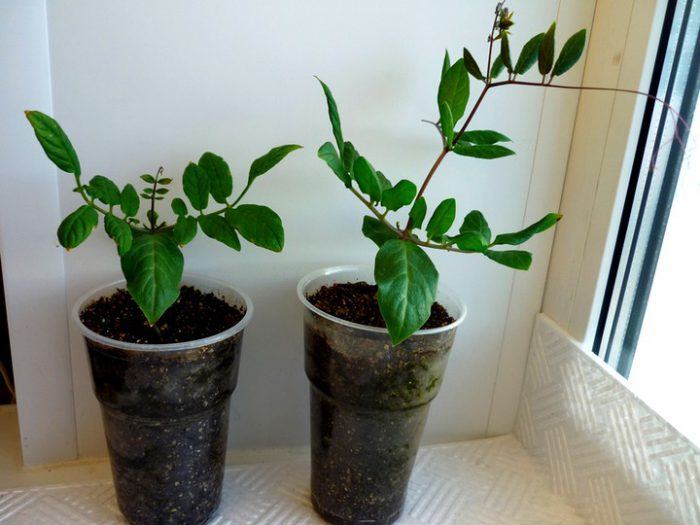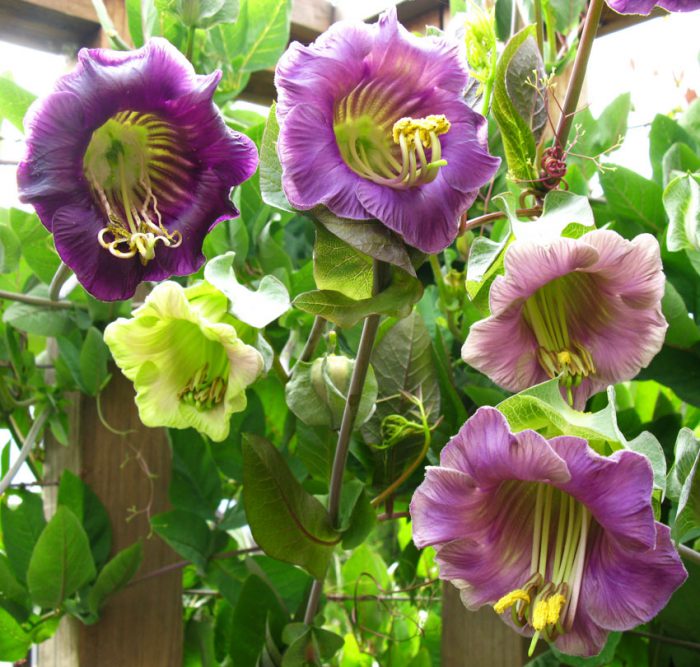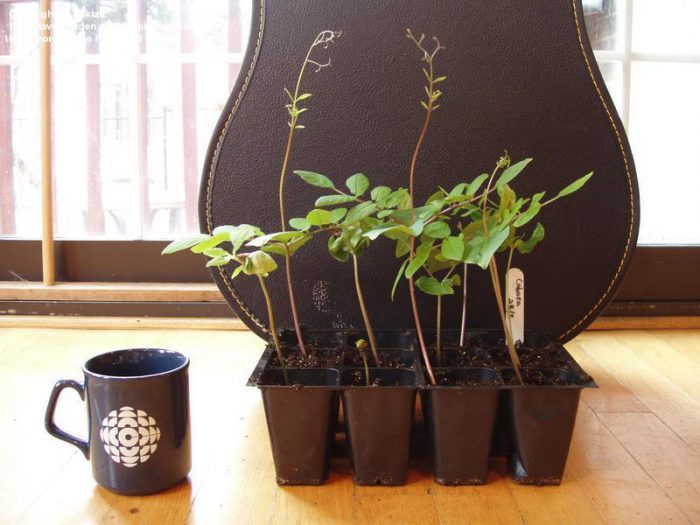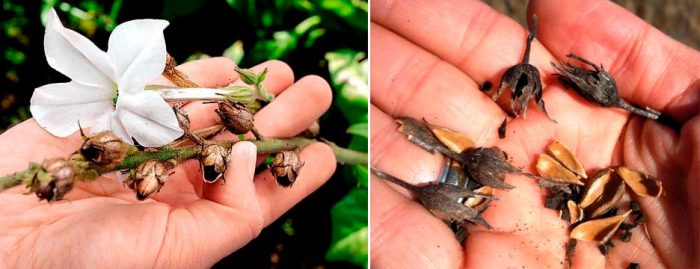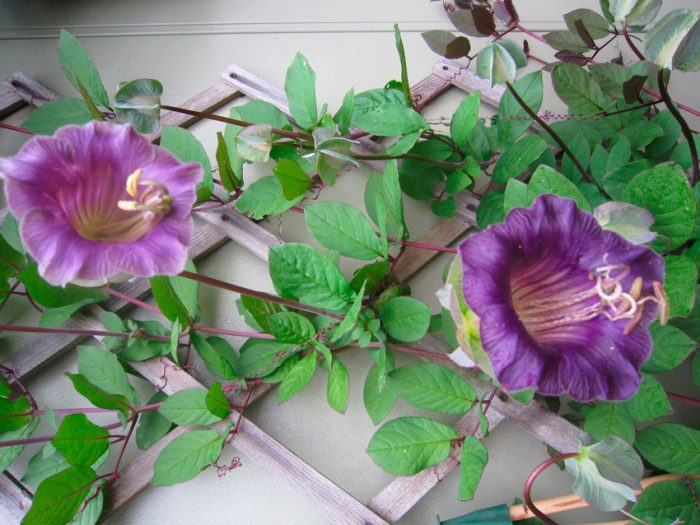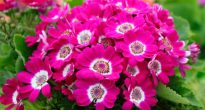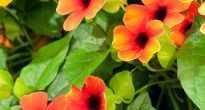Liana kobea (Cobaea) is a climbing dwarf shrub that is an annual and belongs to the cyanide family. It is cultivated by gardeners as an annual plant. This vine was named after Barnabas Kobo, who was a naturalist monk and lived in the plant's homeland (Peru and Mexico) for several years. In nature, the kobei can be found in the humid tropical and subtropical forests of North and South America. Such a plant has been cultivated since 1787, while it is most often used for vertical gardening of arbors or hedges.
Content
Kobei features
This plant is fast growing. In this regard, the branched root system is very strong and has many thin fibrous roots. Shoots can be up to 6 meters long and even in some cases much more. The composition of the next complex-pinnate spectacular leaf plates includes only 3 lobes. At the tips of the stems, the leaves change and become branched antennae, which help the shrub to climb up the support, clinging to it with their help. The large flowers are bell-shaped and reach a diameter of 8 centimeters, their pistil and stamens are protruding. The flowers have long stalks and grow from the leaf axils in groups of 2 or 3 or arranged singly. When the flowers are just starting to open, they are colored yellowish green. And after full disclosure, the flowers change their color to white or purple. The fruit is a leathery capsule that opens along the side seams. Inside it are large, flat, oval seeds.
Growing kobei from seeds
Sowing
It is not so easy to grow a kobei from seeds, but it is quite possible. The fact is that the shell of large seeds is very dense, which greatly complicates the appearance of sprouts. Therefore, before sowing, such a shell must be dissolved to such a state that it looks like mucus, and then removed by hand. To do this, you need to spread the seeds on the bottom of the container, which should be wide enough, while taking into account that they should not come into contact with each other. Pour water into the container and close it very tightly with a lid to prevent evaporation of the liquid.From time to time it is necessary to check the seeds and at the same time remove the sagging part of the shell, and then lower them again into the container. It usually takes several days for the seeds to completely clear of the shell.
For seedlings, this plant should be sown in February or the first days of March. For sowing, it is recommended to use individual, not very large cups, in which one seed is placed at a time, thus you do not have to injure young plants during a dive. To plant seeds, it is recommended to use a universal soil. The seed must be laid on the soil surface, while the flat side must be turned down, and then sprinkled on top of it with a layer of the same soil mixture, the thickness of which must be 15 millimeters. Seedlings appear after a different amount of time. If you properly prepared the seeds and completely removed the entire shell, then the seedlings may appear in half a month.
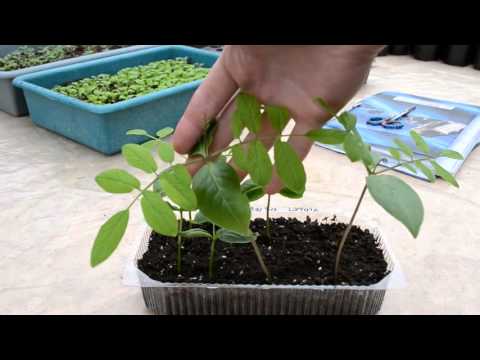

Watch this video on YouTube
Seedling
When the seedlings grow up a little, and they have 2 true leaf plates, they should be dived together with a lump of earth in containers, which should have a volume of about three liters. This will create a strong root system and powerful stems. During transplanting, do not forget to put special ladders made of metal or plastic in the container, in this case the seedling will grow using it as a support. At the same time, you should begin to harden the seedlings. To do this, the plant is transferred to a loggia or balcony, which must be insulated or, in extreme cases, glazed. The plants will stay here before transplanting, while slowly getting used to the cold air. As a rule, three weeks of hardening is enough to get the plants fully accustomed to the outdoor climate. Then you can start planting grown and matured seedlings in open ground.
Landing in open ground
What time to plant
Seedlings are transplanted into open soil in May or at the beginning of June, while the frost should be left behind. And the night temperature should not be less than 5 degrees. However, it is impossible to delay planting for too long, because the plants in this case will outgrow, and transplanting into the garden will be much more complicated.
Disembarkation
First, decide on the place where the kobei will grow. For them, it is recommended to choose a well-lit place with nutritious soil. However, such a flower can also be grown in a shaded area. It should be noted that this shrub must be protected from the cold wind. First you need to prepare the landing pits, the distance between which should be from 50 to 100 centimeters. They need to be filled with a loose soil mixture consisting of humus, peat and sod land. In them it is necessary to lower the plant along with a lump of earth, bury it and water it well. Immediately next to the bushes, you need to put a support (arch or fence), since the growing shrub must climb it, and not along the bushes or trees located nearby. In the event that the threat of frost still remains, then the plant will need to be covered for a while with non-woven covering material, folded in 2 layers.
Care features
Kobei should be watered systematically, while watering should be more abundant during a long dry period. But it must be borne in mind that if the liquid stagnates in the roots, this will provoke the development of rot. You need to be especially careful in watering if the shrub grows in a shaded place.
At the beginning of active growth, such a plant needs frequent feeding, which are carried out once a week, and for this it is recommended to use nitrogen-containing fertilizers. During budding, the kobe will need potassium and phosphorus. They begin to feed the plant almost immediately after the seedlings appear. Then when the first leaf is formed in the plant, it will need to be fed with humate.After that, the kobei is fed alternately with mineral fertilizers (for example, Kemir) and organic matter (mullein infusion) until the very beginning of flowering. In order for the vine to develop and grow normally, it is necessary to systematically loosen the soil surface and pull out weeds.
How to propagate
As mentioned above, kobei can be grown from seed, and can also be propagated by cuttings. Cuttings are taken from uterine bushes, which must stay indoors all winter. When the active growth of young shoots begins in the spring, some of them can be cut off and stuck into moistened sand for rooting. The rooted cutting should be transplanted into open soil in the last days of May or the first in June. Such plants begin to bloom somewhat faster than those grown from seed, but at the same time their flowering is not lush and not so beautiful.
Pests and diseases
Aphids and ticks can settle on the plant. To get rid of such insects, it is necessary to treat the plant with a solution consisting of phytoverm and potassium green soap. Instead of green soap, you can take flea shampoo for animals (it is also used to combat other pests).
After flowering
Seed collection
Flowering begins in July and ends with the onset of frost. In middle latitudes, such a shrub is grown as an annual, which means that it should be burned in the autumn. Seeds in mid-latitudes do not have time to ripen, so they will have to be purchased again at the store for sowing next year. It should be borne in mind that even if you buy seeds of a well-known brand in a store, their germination rate will not be higher than 30 percent.
Wintering
If you wish, you can try to keep the grown kobei until next year. In October, you should cut off all the stems from the bush, carefully dig it and plant it in a large box or flowerpot. You need to store such a plant in a cool, dark place, while the temperature should not exceed 12 degrees. So, a basement or cellar is perfect for storage. Make sure that the substrate does not dry out; for this, water it once every 20-30 days. In the last days of February, the first - March, the bush should be rearranged in a bright and warm place and watering should be gradually increased. The bush is planted in the garden only after the threat of frost has completely passed.
The main types and varieties with photos
Cobea tenacious, or climbing cobea, creeping cobea (Cobaea scandens)
This species is the only one that is cultivated. Moreover, there are 9 types of kobei in nature. This species is a perennial vine that is cultivated as an annual. The homeland of this plant is Mexico. This vine grows a large number of stems, reaching 6 m in length. The plumose leaf plates end in branched tendrils with which the plant clings to the support. Flowering lasts from the second half of the summer period until the very frost. Flowers of purple color have a honey smell. The white kobei (Cobea scandens alba) is a subspecies of the cobei tenacious and has white flowers.
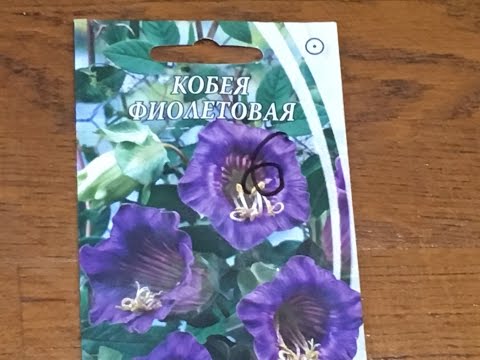

Watch this video on YouTube

